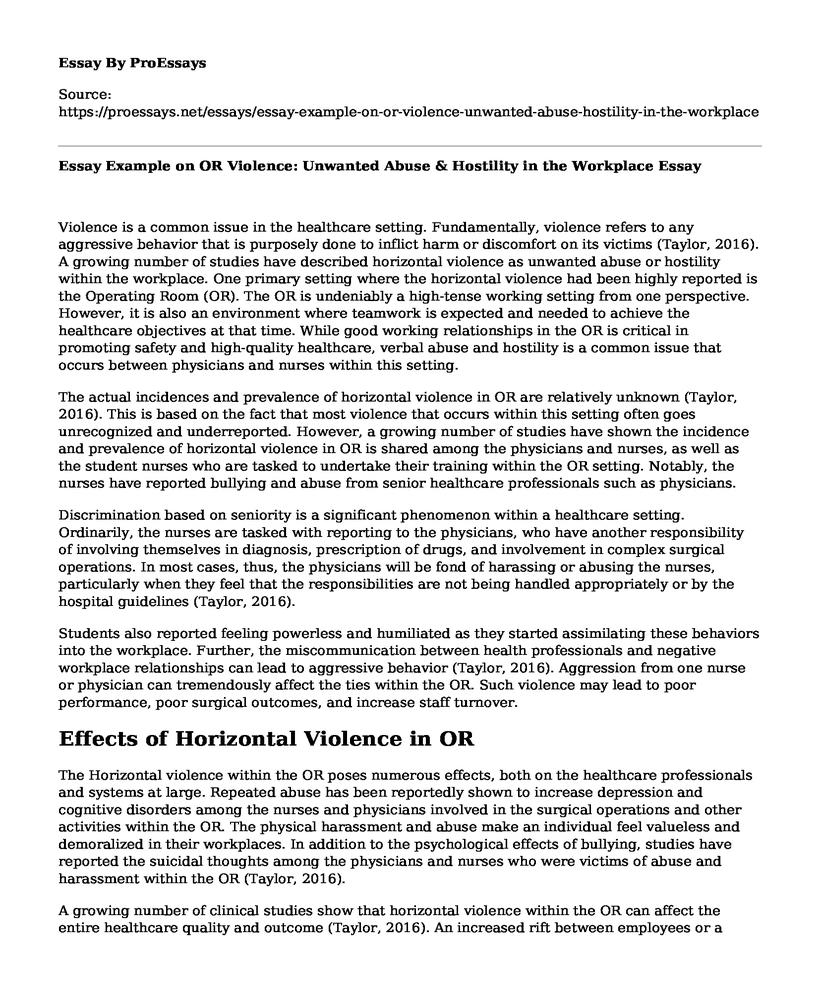Violence is a common issue in the healthcare setting. Fundamentally, violence refers to any aggressive behavior that is purposely done to inflict harm or discomfort on its victims (Taylor, 2016). A growing number of studies have described horizontal violence as unwanted abuse or hostility within the workplace. One primary setting where the horizontal violence had been highly reported is the Operating Room (OR). The OR is undeniably a high-tense working setting from one perspective. However, it is also an environment where teamwork is expected and needed to achieve the healthcare objectives at that time. While good working relationships in the OR is critical in promoting safety and high-quality healthcare, verbal abuse and hostility is a common issue that occurs between physicians and nurses within this setting.
The actual incidences and prevalence of horizontal violence in OR are relatively unknown (Taylor, 2016). This is based on the fact that most violence that occurs within this setting often goes unrecognized and underreported. However, a growing number of studies have shown the incidence and prevalence of horizontal violence in OR is shared among the physicians and nurses, as well as the student nurses who are tasked to undertake their training within the OR setting. Notably, the nurses have reported bullying and abuse from senior healthcare professionals such as physicians.
Discrimination based on seniority is a significant phenomenon within a healthcare setting. Ordinarily, the nurses are tasked with reporting to the physicians, who have another responsibility of involving themselves in diagnosis, prescription of drugs, and involvement in complex surgical operations. In most cases, thus, the physicians will be fond of harassing or abusing the nurses, particularly when they feel that the responsibilities are not being handled appropriately or by the hospital guidelines (Taylor, 2016).
Students also reported feeling powerless and humiliated as they started assimilating these behaviors into the workplace. Further, the miscommunication between health professionals and negative workplace relationships can lead to aggressive behavior (Taylor, 2016). Aggression from one nurse or physician can tremendously affect the ties within the OR. Such violence may lead to poor performance, poor surgical outcomes, and increase staff turnover.
Effects of Horizontal Violence in OR
The Horizontal violence within the OR poses numerous effects, both on the healthcare professionals and systems at large. Repeated abuse has been reportedly shown to increase depression and cognitive disorders among the nurses and physicians involved in the surgical operations and other activities within the OR. The physical harassment and abuse make an individual feel valueless and demoralized in their workplaces. In addition to the psychological effects of bullying, studies have reported the suicidal thoughts among the physicians and nurses who were victims of abuse and harassment within the OR (Taylor, 2016).
A growing number of clinical studies show that horizontal violence within the OR can affect the entire healthcare quality and outcome (Taylor, 2016). An increased rift between employees or a group of employees can destroy teamwork and collaboration in the OR, leading to increased medical or surgical errors, reduced chances of patient's survival, and increased death because of the limited workforce attributed to the increased staff turnover (Hamlin, 2000).
The omission of the critical information related to patient care as a result of the violence within the OR subjects the victim nurse of a physician in a weak position to care for the patients after the operation (Hamlin, 2000). This move undeniably compromises the patient's safety. Additionally, the subsequent cost to the patent family, and the institution care, in addition to the possible legal action, can be huge.
Preventing the Horizontal Violence in OR
A closer look at the healthcare environment that many challenges that contribute to the violence still exist. Factors such as the inadequate staffing, increased patient acuity as well as reduced resource combine to provide the room for stress and conflict play a critical role in helping the violence to thrive (Taylor, 2016). It is thus necessary for the leaders in healthcare to provide the resources aimed at reducing job stress, depression, and anxiety among the nurse who cares for their patients. Nevertheless, the nurse leaders must be ready to provide the support staff within the OR with the constructive, real feedback whenever required and appropriate.
References
Hamlin, L. (2000). Horizontal violence in the operating room. British Journal of Perioperative Nursing (United Kingdom), 10(1), 34-42.
Taylor, R. (2016). Nurses' perceptions of horizontal violence. Global qualitative nursing research, 3, 2333393616641002.
Cite this page
Essay Example on OR Violence: Unwanted Abuse & Hostility in the Workplace. (2023, May 17). Retrieved from https://proessays.net/essays/essay-example-on-or-violence-unwanted-abuse-hostility-in-the-workplace
If you are the original author of this essay and no longer wish to have it published on the ProEssays website, please click below to request its removal:
- Presentation on Bullying in Schools
- Situation Report on Police Biases Essay Example
- Article Analysis Essay on "Accidents on the Road"
- Professional Socialization in the Mental Health Nursing Profession Paper Example
- Violence in Video Games Effect on Children Essay Example
- Essay Sample on Exploring Cultural Bias and Cry for Freedom
- Essay Example on Jorge & Marisa's Attitudes Impact View of Work Schedules







